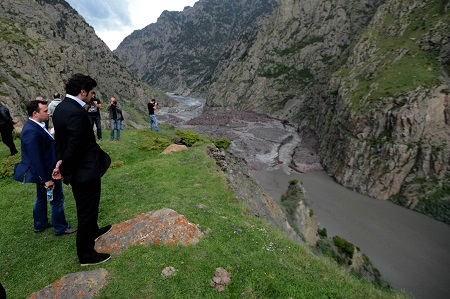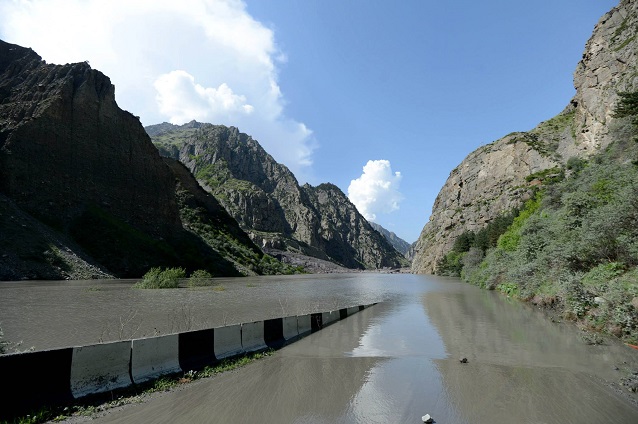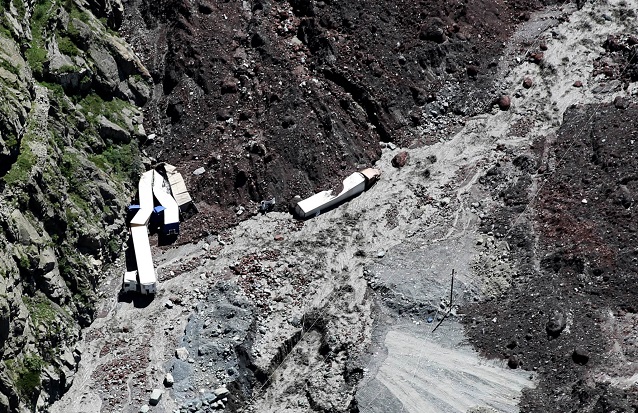Dariali: Fight against disaster


The damage and losses are significant but the exact sum is still unknown. The Georgian Government allocated 7 million GEL to the rescue efforts and clean-up work.
Read the blog of Energy Minister Kakha Kaladze, who played an important part in the immediate aftermath of the disaster.
I have never felt a man’s weakness against nature before. Even in winter when heavy snow caused high voltage cables to be shut off in Adjara, we fought against the disaster for 24 hours each day in terrible conditions, in bitterly cold temperatures where snow cover was as tall as people. Strangely enough, this fight would give us more strength and the result of our efforts in those cold nights was visible.

Kakhi Kaladze in Ajara, December 2013. Photo by Kaladze's press office.
Dariali was different, there were victims. When a human life is in danger, you have to work under huge pressure in a tragic and stressing environment. This is extremely difficult.
A landslide from Mount Kazbek came down to Devdoraki Gorge first and then from there, onto Dariali highway about 10am (on May 17).
We – representatives of different Ministries – arrived there shortly after 11am. Before our arrival, workers from nearby Larsi Hydro Power Station had begun working to clean up this huge mass of mud, ice and land.

This is how the road connecting Russia and Georgia looked like after the landslide. Photo by the Ministry of Energy.
Everyone saw on TV what happened next. Emergency services evacuated local residents, tourists and passengers who were stuck on the other side of the landslide.
The disaster prompted our Ministry to worry about one more thing – it split a transit gas pipeline. Immediate work began to fix this too.

Trucks recovered by the rescuers in Dariali. Photo by the Ministry of Energy.
Besides state machinery, it was of a great help that [the hydro power plant] assisted with their personal machinery.
Thanks to the power plant’s location, the mud and debris from the disaster did not overflow beyond the Russian border. Russian media even thanked us when they underlined the power station’s role in reducing the scale of the catastrophe.

Rescue opereation in the Dariali Gorge. Photo by the Ministry of Energy.
I find it surprising and offensive that some of the green NGOs are very biased in terms of hydro power plants. When there are so many ecological problems in the country and the country has a great hydro potential, it is very sad that instead of informing the population about this, they participate in argument-less protests. Sometimes they fight against small hydro power pants, sometimes against derivative ones and sometimes against those with a reservoir.
After returning to Tbilisi, I was provided with more information about previous incidences in Dariali. A terrible catastrophe happened in 1832 when a huge glacier, together with its gravel, fell down into Dariali Gorge. It blocked Tergi River for three days. Tergi then broke through the barrier and flooded Vladikavkaz (capital city of Northern Ossetia, Russia).
It is interesting to note that the glacier, back then, had been melting for seven years.

Kakhi Kaladze discussing the details of operation in Dariali. Photo by Ministry of Energy.
Devdoraki is threating us with further landslides. One of our companies has installed alarming systems near Mt Kazbek. Traffic is limited along the highway.
But everything will be alright. Nature and human are like an inseparable couple who are in love with each other. They fight and rage at each other but they are still integral parts of each other.
 Tweet
Tweet  Share
Share